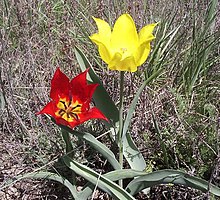Tulipa gesneriana
| Tulipa gesneriana | |
|---|---|
 |
|
|
Tulipa gesneriana in Bogdo-Baskunchak Nature Reserve, Astrakhan Oblast, Russia |
|
| Scientific classification | |
| Kingdom: | Plantae |
| (unranked): | Angiosperms |
| (unranked): | Monocots |
| Order: | Liliales |
| Family: | Liliaceae |
| Genus: | Tulipa |
| Species: | T. gesneriana |
| Binomial name | |
|
Tulipa gesneriana L. |
|
| Synonyms | |
|
Synonymy
|
|
Tulipa gesneriana, the Didier's tulip or garden tulip, is a species of plants in the lily family, cultivated as an ornamental in many countries because of its large, showy flowers. Its region of origin is not entirely certain, but the species is widely believed to have originated in Turkey, as is the case with many species of tulips that came into Europe from the Ottoman Empire. It has become naturalised in parts of central and southern Europe and scattered locations in North America. Most of the cultivated forms of tulip are derived from Tulipa gesneriana.
This tall, late-blooming species has a single blooming flower and linear or broadly lanceolate leaves.
When the tulip originally arrived in Europe from the Ottoman Empire, its popularity soared and it quickly became a status symbol for the newly wealthy merchants of the Dutch Golden Age. As a mosaic virus began to infect bulbs, producing rare and spectacular effects in the bloom but weakening and destroying the already limited number of bulbs, a speculative frenzy now known as tulip mania was triggered between 1634 and 1637. Bulbs were exchanged for land, livestock, and houses, and the Dutch created futures markets where contracts to buy bulbs at the end of the season were bought and sold. A single bulb, the Semper Augustus, fetched 6,000 florins in Haarlem — at that time, a florin could purchase a bushel of wheat.
The flower and bulb can cause dermatitis through the allergen, tuliposide A, even though the bulbs may be consumed with little ill effect. The sweet-scented bisexual flowers appear during April and May. Bulbs are extremely resistant to frost and can tolerate temperatures well below freezing — a period of low temperature is necessary to induce proper growth and flowering, triggered by an increase in sensitivity to the phytohormone auxin.
...
Wikipedia
